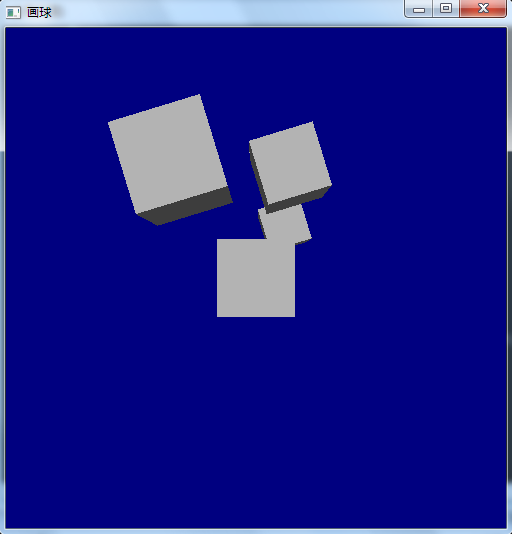视点跟踪一个节点运动的原理是:把物体矩阵取反。。
#include <stdlib.h>#include <stdio.h>#include <gl/glut.h>#include <math.h>#include <time.h>GLfloat angle = 0.0;GLfloat theta = 0.0, vp = 6;//vp视点的位置GLfloat cenx, ceny;const int PI = 3.1415926;const double N = 200.0;int myWin;const int MAX_MAP = 500;int myMap[MAX_MAP][MAX_MAP];inline double aToR(double x){ return x/180.0 * 3.1415926;}void openLight(){ float light_position[4] = {30, 30, 30, 0}; float light_ambient[4] = {1.0, 1.0, 1.0, 1.0}; float light_diffuse[4] = { 1.0, 1.0, 1.0, 1.0}; glLightfv(GL_LIGHT0,GL_POSITION,light_position); glLightfv(GL_LIGHT0,GL_AMBIENT,light_ambient); glLightfv(GL_LIGHT0, GL_DIFFUSE, light_diffuse); glEnable( GL_LIGHTING ); glEnable( GL_LIGHT0 );}void cube(){ typedef float point3[3]; typedef int edge[2]; typedef int face[4]; point3 vertices[8] = { {-1.0, -1.0, -1.0}, {-1.0, -1.0, 1.0}, {-1.0, 1.0, -1.0}, {-1.0, 1.0, 1.0}, {1.0, -1.0, -1.0}, {1.0, -1.0, 1.0}, {1.0, 1.0, -1.0}, {1.0, 1.0, 1.0} }; point3 normals[6] = { {-1.0, 0.0, 0.0}, {0.0, 0.0, 1.0}, {0.0, 1.0, 0.0}, {0.0, 0.0, -1.0}, {0.0, -1.0, 0.0}, {1.0, 0.0, 0.0} }; edge edges[24] = { {0, 1}, {1, 3}, {3, 2}, {2, 0}, {0, 4}, {1, 5}, {3, 7}, {2, 6}, {4, 5}, {5, 7}, {7, 6}, {6, 4}, {1, 0}, {3, 1}, {2, 3}, {0, 2}, {4, 0}, {5, 1}, {7, 3}, {6, 2}, {5, 4}, {7, 5}, {6, 7}, {4, 6} }; face cube[6] = { {0, 1, 2, 3}, {5, 9, 18, 13}, {14, 6, 10, 19}, {7, 11, 16, 15}, {4, 8, 17, 12}, {22, 21, 20, 23} }; //GLdouble myClipPlane[] = {1.0, 1.0, 0.0, -1.0}; //glClipPlane(GL_CLIP_PLANE0, myClipPlane); ///glEnable(GL_DEPTH_TEST); //glEnable(GL_CLIP_PLANE0); glBegin(GL_QUADS); for(int face = 0; face < 6; face ++) { glNormal3fv(normals[face]); for(int edge = 0; edge < 4; edge ++) { glVertex3fv(vertices[edges[cube[face][edge]][0]]); } } glEnd(); //glDisable(GL_CLIP_PLANE0);}void qumian(){ glLineWidth(10); glBegin(GL_LINES); glVertex3f(40, 0, 0); glVertex3f(0, 20, 0); glEnd();}void display(void){ glClear( GL_COLOR_BUFFER_BIT | GL_DEPTH_BUFFER_BIT); glEnable(GL_DEPTH_TEST); glClearColor(0, 0, 0.5, 1); openLight(); glMatrixMode(GL_MODELVIEW); glLoadIdentity(); gluLookAt(0, 0, 0, 0.0, 0.0, -1.0, 0.0, 1.0, 0.0); glTranslatef(0, 0, -12); //glTranslatef(0, -5, 0); glRotatef(-angle, 0.0, 0.0, 1.0); //glScalef(10, 10, 10); glPushMatrix(); glRotatef(angle, 0.0, 0.0, 1.0); //glTranslatef(0, 5, 0); cube(); glPopMatrix(); glPushMatrix(); glTranslatef(2, 2, -9); cube(); glPopMatrix(); glPushMatrix(); glTranslatef(2, 3, -2); cube(); glPopMatrix(); glPushMatrix(); glTranslatef(-1, 3, 2); cube(); glPopMatrix(); glutSwapBuffers(); }void reshape(int w, int h){ int min = w < h?w:h; int cenx = w * 0.5; int ceny = h * 0.5; glViewport(cenx - min*0.5, ceny - min*0.5, (GLsizei)min, (GLsizei)min); glMatrixMode(GL_PROJECTION); glLoadIdentity(); gluPerspective(60, 1, 0.1, 300.0); glutPostRedisplay();}void iterationStep(void){ angle += 1.0; cenx = cos(angle / 180 * 3.14159) * vp + vp; ceny = sin(angle / 180 * 3.14159) * vp;}void animate(void){ iterationStep(); glutPostRedisplay();}int main ( int argc, char ** argv ){ glutInit(&argc, argv); glutInitDisplayMode(GLUT_DOUBLE | GLUT_RGB | GLUT_DEPTH); //这里必须使用双缓冲区,双缓冲区通过在后一个缓冲区里绘画,并不停交换前后缓冲区(可见缓冲区),来产生平滑的动画,使用双缓冲区可以有效的预防闪烁。 glutInitWindowSize(500, 500); glutInitWindowPosition(50, 50); myWin = glutCreateWindow("画球"); glutDisplayFunc(display); glutReshapeFunc(reshape); glutIdleFunc(animate); glutMainLoop();}最终效果图如下所示:

再分享一下我老师大神的人工智能教程吧。零基础!通俗易懂!风趣幽默!还带黄段子!希望你也加入到我们人工智能的队伍中来!https://blog.csdn.net/jiangjunshow





















 1670
1670

 被折叠的 条评论
为什么被折叠?
被折叠的 条评论
为什么被折叠?








